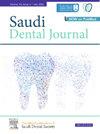Adapting to emergent paradigm shifts: A calibration study among graduating dental students using the new classification of periodontal diseases
IF 2.3
Q3 DENTISTRY, ORAL SURGERY & MEDICINE
引用次数: 0
Abstract
Introduction
The World Workshop on the Classification of Periodontal and Peri-implant Diseases and Conditions introduced the 2018 Classification. Formulating periodontal diagnosis differs from clinician to clinician and depends on the expertise and competence of the clinician. We aimed to assess calibration levels of periodontal diagnosis based on the 2018 classification among senior-year dental interns at Batterjee Medical College in Saudi Arabia preparing for practice and subsequent graduation.
Materials and Methods
In this preapproved study, 52 senior-year dental students received a two-hour presentation on the 2018 classification by a single teacher, followed by a preliminary exam. One week later, the students were subjected to 12 study cases demonstrating a variety of periodontal and peri-implant disorders with gold standard management, followed by a post-test. Case scenarios with photographs, knowledge cognition, knowledge recall, and case scenarios were the four areas of both exams. Kappa statistics were computed to determine agreement. Statistical significance was set at p < 0.05.
Results
The total examination score was 12.69 ± 2.74 and 15.12 ± 2.99 (p = 0.001) for the pre- and post-tests, respectively. Furthermore, the difficulty factor and discrimination index increased by 12 % (p = 0.007) and 7 % (p = 0.244), respectively. Finally, the kappa statistic showed moderate agreement at 0.427 (p = 0.002).
Conclusion
Inter-rater agreement with the gold standard increased after training, and this improvement was fairly successful in providing graduating dental students with diagnostic abilities simultaneously with the emergence of a new classification system. A calibration procedure based on a simple feedback approach provided beneficial outcomes.
适应新兴的范式转变:一项使用牙周病新分类的牙科毕业生校准研究
世界牙周和种植体周围疾病和病症分类研讨会介绍了2018年的分类。制定牙周诊断因临床医生而异,取决于临床医生的专业知识和能力。我们的目的是评估基于2018年分类的牙周诊断校准水平在沙特阿拉伯巴特吉医学院大四牙科实习生准备实习和随后的毕业。材料和方法在这项预先批准的研究中,52名大四的牙科学生接受了一名老师关于2018年分类的两个小时的介绍,然后进行了初步考试。一周后,学生们接受了12个研究案例,在金标准管理下展示了各种牙周和种植体周围疾病,然后进行了后测试。带照片的案例场景、知识认知、知识回忆和案例场景是这两项考试的四个领域。计算Kappa统计量以确定一致性。p <;0.05.结果前、后检总分分别为12.69±2.74分和15.12±2.99分(p = 0.001)。难度系数和鉴别指数分别提高了12% (p = 0.007)和7% (p = 0.244)。最后,kappa统计量显示中度一致性,为0.427 (p = 0.002)。结论经过培训后,评分者与金标准的一致性提高了,这种提高在为即将毕业的牙科学生提供诊断能力的同时,也为新的分类体系的出现提供了相当成功的帮助。基于简单反馈方法的校准程序提供了有益的结果。
本文章由计算机程序翻译,如有差异,请以英文原文为准。
求助全文
约1分钟内获得全文
求助全文
来源期刊

Saudi Dental Journal
DENTISTRY, ORAL SURGERY & MEDICINE-
CiteScore
3.60
自引率
0.00%
发文量
86
审稿时长
22 weeks
期刊介绍:
Saudi Dental Journal is an English language, peer-reviewed scholarly publication in the area of dentistry. Saudi Dental Journal publishes original research and reviews on, but not limited to: • dental disease • clinical trials • dental equipment • new and experimental techniques • epidemiology and oral health • restorative dentistry • periodontology • endodontology • prosthodontics • paediatric dentistry • orthodontics and dental education Saudi Dental Journal is the official publication of the Saudi Dental Society and is published by King Saud University in collaboration with Elsevier and is edited by an international group of eminent researchers.
 求助内容:
求助内容: 应助结果提醒方式:
应助结果提醒方式:


